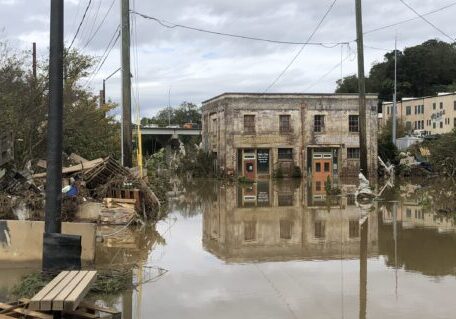March 19, 2024
Peaker Plant Reliability Must Run (RMR) Designation: Expensive and Flawed
By Shelley Hudson Robbins
In every Federal Energy Regulatory Commission (FERC) meeting, every Independent System Operator (ISO) meeting, and every utility commission meeting across the country, the hottest topic on the agenda is reliability.¹ Utilities and grid operators work night and day to keep the system running, but reliability concerns heightened considerably after Winter Storm Uri took down much of the Texas grid in 2021. More than 246 lives were lost. Winter Storm Elliott then posed a credible threat to the mid-Atlantic PJM grid in 2022. And the New York ISO has projected that there will not be enough power available to reliably meet peak summer demand in 2025 if the dirtiest peaker power plants in New York City retire and stop polluting surrounding neighborhoods as required by state environmental regulations.
Losing power in the middle of a winter deep-freeze or during a series of scorching summer days can be life-changing, especially for citizens who do not have the means to do anything other than shelter in place. It is for this reason that state and federal regulatory bodies are working to guarantee enough reliable electricity generation on the grid to make sure life-threatening outages do not happen. The typical tactics they have used over the past few years have been to approve new gas generation and to delay the retirement of the oldest and dirtiest plants in the energy fleet, keeping them on standby for grid emergencies. This second tactic is called a Reliability Must Run, or RMR order.
An RMR order can be issued by either an ISO or by FERC when a power plant resource owner informs the ISO that it would like to retire a unit. The operator may want to retire it for economic reasons – it costs more to operate than it generates in revenue – or because it can no longer meet air quality requirements. If the ISO determines that the unit is needed for future reliability, it issues an RMR for that unit, regardless of the economic impacts to ratepayers and health and environmental impacts to surrounding communities. The operator can then use either an ISO formula or a FERC process to determine how much the operator will get paid to remain available for a specified number of years. These payments are typically much higher than what they were getting paid by the market before they notified the ISO of the request to retire the unit.
The PJM Market Monitor, a watchdog of sorts for the ISO, has noted that RMR designation gives “significant market power” to the owners of these units in establishing compensation for the extended operation.² The Market Monitor found that companies using the FERC compensation process included inappropriate costs, such as costs incurred prior to the deactivation notice and costs associated with final closure of the unit that would have been incurred anyway. These costs are ultimately passed on to ratepayers. In PJM, an RMR has been issued for NRG’s Indian River 4 coal plant in Delaware. It was scheduled to retire in 2022, but now it will remain operational under FERC’s Cost of Service Recovery Rate, costing ratepayers almost $78 million per year, until the end of 2026.³
In 2018, Exelon Generation notified ISO-NE that it could no longer economically operate the large Mystic gas plants near Boston after June 1, 2022. Ultimately, FERC approved a compensation level to keep Mystic’s two largest remaining units – 708-megawatt Unit 8 and 714-megawatt Unit 9 – operating until May of 2024. Exelon turned operations of their fossil fleet over to Constellation Energy, and between June of 2022 and March of 2023, ISO-NE paid Constellation $436 million in Supplemental Capacity Payments (ranging from $2.5 million in August 2022 to $120 million in January 2023).⁴ When this amount is applied to Mystic’s actual electricity output during that ten month period, it equates to payments of $211 per megawatt-hour in the fourth quarter of 2022 and $339 per megawatt-hour for Mystic’s actual output during the first quarter of 2023. And yet, when the region experienced a capacity scarcity on December 24, 2022 – Mystic was offline.⁵
In addition to the general cost of RMR designations, there remain questions about the actual reliability of these units. The Indian River plant is old (built 44 years ago in 1980) and coal fired. Both of these aspects pose reliability threats, especially in the winter. Winter Storms Uri and Elliott widely revealed that coal piles freeze, rendering some coal plants unable to operate during winter grid emergencies. In ERCOT during Uri, almost 4-gigawatts of coal capacity were offline. In PJM during Elliott, 7.5-gigawatts of coal capacity were offline.
Gas is not consistently reliable either, as noted above – Mystic, a power plant being paid to be a reliability asset – was offline when it was needed during Elliott. In NYISO, two sets of 53-year-old gas peaker units have been identified as reliability resources for the forecasted summer 2025 capacity deficit. These units – Gowanus and Narrows – were slated to retire in 2025 because they can no longer meet air quality standards. AlphaGen, the operator of these two plants, had proposed replacing these aging units with battery storage. Now that offer – to remove polluting power generation with questionable actual reliability capability from an overburdened community – appears to be on hold.
Perhaps the most overlooked negative impact of designating the old, dirty, expensive units as RMR – and thus requiring them to at least attempt to be available for grid emergencies – is that these units must now fire up on a routine schedule for testing. For coal plants, this can take days at a time. This means that even if these RMR plants are not actually needed at all during the year, they still get paid and they still pollute and poison the communities that surround them.
The RMR concept is expensive and flawed, and there are cost-effective non-combustion alternatives available today that could be deployed instead of RMR designations to meet reliability needs. These alternatives include compensated and aggregated demand response programs, virtual power plants, battery storage, distributed solar, and aggressive energy efficiency. Deploying these alternatives is not as easy as issuing an RMR order, but they are reliable, they save lives, and they strengthen communities. Clean Energy Group’s Phase Out Peakers initiative works to systematically demonstrate that fossil peaker plants, especially those located in historically over-burdened communities, can and should be prioritized for closure. Prolonging local pollution for a false sense of security is expensive, unreliable, and unjust.
_____________________
(1) Independent System Operators include the grid operators ISO New England, New York ISO, PJM, Midcontinent ISO (MISO), California ISO (CAISO), and the Electric Reliability Council of Texas (ERCOT)
(2) “State of the Market Report for PJM, Q3 2023, January through September,” Monitoring Analytics, LLC, November, 9, 2023, p. 362.
(3) From p. 362 of the 2023 PJM Market Monitor Report, 410MWx$520.25 per MW-dayx365
(4) FERC filing ER18-1639 Motion for Disclosure of Audit Information
(5) ibid














